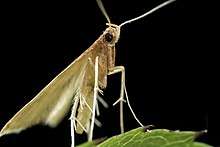Thambotricha
Thambotricha is a monotypic genus of moths in the family Epermeniidae. Its sole known species, Thambotricha vates, is also known by the vernacular name wonder-haired prophet. It is endemic to New Zealand. This species is classified as "At Risk, Naturally Uncommon" by the Department of Conservation.
| Thambotricha | |
|---|---|
 | |
| Scientific classification | |
| Kingdom: | |
| Phylum: | |
| Class: | |
| Order: | |
| Family: | |
| Genus: | Thambotricha |
| Species: | T. vates |
| Binomial name | |
| Thambotricha vates Meyrick, 1922[2] | |
Taxonomy and etymology
T. vates was described by Edward Meyrick in 1922 from a specimen collected in Wellington by C. E. Clarke.[3] George Hudson discussed and illustrated the species in his 1928 book The Butterflies and Moths of New Zealand.[4] The holotype specimen is held at the Natural History Museum, London.[5] The vernacular name of this species, "wonder-haired prophet", comes from a translation of its Latin name.[6] The name is as a result of the male having very long hairs on its antenna.[6]
Description
Meyrick described the species as follows:
♂︎ 14mm. Head pale ochreous, side-tufts bronzv. Palpi bronzy-fuscous. Antennal ciliations 8. Thorax purple-bronzy-ochreous. Abdomen whitish-ochreous. Fore wings elongate, narrowed towards base, costa sinuate, apex pointed, termen faintly sinuate, oblique ; pale yellow overlaid with purple-bronzy-ochreous, costal edge pale yellow from 2⁄5 to 4⁄5 ; discal stigmata remote, rather dark fuscous, an additional dot beneath and rather before second, these two partially surrounded with pale yellowish ; a slender terminal streak of purple-fuscous suffusion ; cilia whitish-yellowish, on costa suffused purple-ochreous, darkest above apex, on dorsum pale ochreous tinged purple, cilia extending to before middle of dorsum. Hind wings and cilia ochreous-whitish.[3]
Distribution
This species is endemic to New Zealand.[2][7] Along with its type locality of Gollan's Valley in Wellington,[4] this moth has also been collected at the Waipoua State Forest in Northland,[8] in the Hakarimata Range near Ngāruawāhia in the Waikato,[8] in Taranaki,[9] at Katikati in the Bay of Plenty,[6] and near Aorere River in Nelson.[4]
Biology and life cycle
Little is known of the biology of this species.[6][10] T. vates are on the wing in March.[3] This species appears not to attracted to light and has been caught by sweeping during daytime.[6][8] Males of the species have been however been collected at night with the use of a pressure lamp.[8]
Host species and habitat
The host species of the larvae of this moth is unknown.[6][10] This species prefers native forest habitat.[6]
Conservation status
This species has been classified as having the "At Risk, Naturally Uncommon" conservation status under the New Zealand Threat Classification System.[11]
References
| Wikimedia Commons has media related to Thambotricha. |
- Beccaloni, G.; Scoble, M.; Kitching, I.; Simonsen, T.; Robinson, G.; Pitkin, B.; Hine, A.; Lyal, C., eds. (2003). "Thambotricha". The Global Lepidoptera Names Index. Natural History Museum. Retrieved April 23, 2018.
- "Thambotricha vates Meyrick, 1922". www.nzor.org.nz. Landcare Research New Zealand Ltd. Retrieved 2018-04-02.
- Meyrick, Edward (1922). "A new genus and species of Microlepidoptera from New Zealand". The Entomologist. 55: 270–271. ISSN 0013-8878. Retrieved 26 May 2018.
- Hudson, G. V. (1928). The Butterflies and Moths of New Zealand. Wellington: Ferguson & Osborn Ltd. p. 325.
- Dugdale, J. S. (1988). "Lepidoptera - annotated catalogue, and keys to family-group taxa" (PDF). Fauna of New Zealand. 14: 1–262.
- "Elusive moth found in Bay of Plenty". Stuff. 22 April 2015. Retrieved 3 April 2018.
- Gordon, Dennis P., ed. (2010). New Zealand inventory of biodiversity. Volume two. Kingdom animalia : chaetognatha, ecdysozoa, ichnofossils. Vol. 2. Christchurch, N.Z.: Canterbury University Press. p. 458. ISBN 9781877257933. OCLC 973607714.
- Dugdale, J. S. (2 February 2012). "Thambotricha vates Meyrick, reassigned to Epermeniidae (Lepidoptera: Epermenioidea)". New Zealand Journal of Zoology. 14 (3): 375–383. doi:10.1080/03014223.1987.10423008.
- Bath, Brooke (2015-04-21). "Rare moth causes a flutter in Katikati". NZ Herald. ISSN 1170-0777. Retrieved 2018-04-02.
- Patrick, Brian; Dugdale, John S. (2000). Conservation status of the New Zealand lepidoptera (PDF). Wellington, N.Z.: Department of Conservation, New Zealand. p. 32. ISBN 0478218672. OCLC 154670803.
- Hoare, R.J.B.; Dugdale, J.S.; Edwards, E.D.; Gibbs, G.W.; Patrick, B.H.; Hitchmough, R.A.; Rolfe, J.R. (2017). "Conservation status of New Zealand butterflies and moths (Lepidoptera), 2015" (PDF). New Zealand Threat Classification Series. 20: 9.